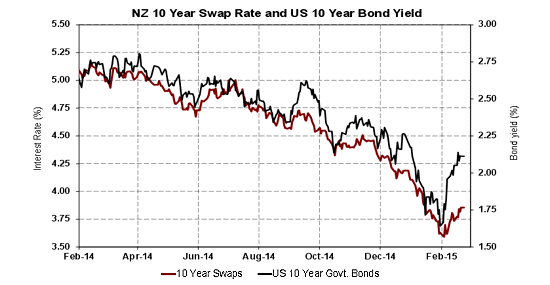
The last three weeks have seen US 10-year Treasury Bond yields reverse in direction and climb from record lows of 1.60% to 2.12%, a 0.52% increase.
Global investor sentiment has improved as Ukraine, Greece and oil crises/shocks have dissipated in intensity and the markets seem less concerned at global geo-political risks.
As a result, the safe-haven investor flows into the US dollar and US Treasury Bonds have decreased and speculative traders have been taking profits and selling bonds (thus rising yields).
Over this time US economic data has been something of a mixed bag with very strong employment numbers, however no real sign yet of increased consumer spending in the US as a result of higher discretionary spending available through lower gasoline pump prices.
Further increases in US bond yields appear likely as the markets prepare for higher short-term interest rates from the Federal Reserve in the second half of 2105.
Market convention and historical patterns are that New Zealand 10-year bond and swap interest rates move in lock-step tandem with the US Treasury Bond yields.
Well, they were doing that up until three weeks ago.
However, the recent 0.52% increase in US interest rates has only produced a 0.25% lift in NZ 10-year swap interest rates from a low of 3.60% to 3.85% today.
It appears that the long-term NZ interest rates have some catching up to do.
There are a couple of reasons for the slowness in NZ interest rate increases to match the reversal upwards in US Treasury Bonds:-
• Foreign investor buying of Kauri bonds outweighing in volume the “paying fixed” demand by local borrowers in the wholesale swaps market.
• Local borrowers being reluctant to fix interest rates any further whilst there is speculation that the RBNZ could cut the OCR as well as increasing it.
Whatever the reasons for the short-term divergence between US and NZ long-term interest rates history tells us that they always re-align themselves.
The completely flat NZ yield curve from 90-days to 10 years provides attractive opportunities for wholesale borrowers to fix via swaps, buy swaptions if there is uncertainty on future debt amounts and enter caps and/or collar options on 90-day rates for periods of three to four years for very little cost.
Eventually that borrower demand on to the wholesale swaps market will become very one-sided and force the catch up to the increase in US Treasury Bond yields.

Daily swap rates
Select chart tabs
Roger J Kerr is a partner at PwC. He specialises in fixed interest securities and is a commentator on economics and markets. More commentary and useful information on fixed interest investing can be found at rogeradvice.com

We welcome your comments below. If you are not already registered, please register to comment.
Remember we welcome robust, respectful and insightful debate. We don't welcome abusive or defamatory comments and will de-register those repeatedly making such comments. Our current comment policy is here.